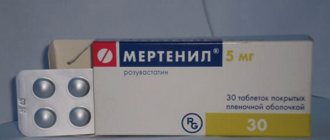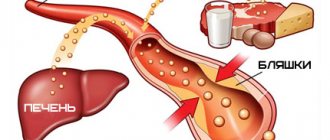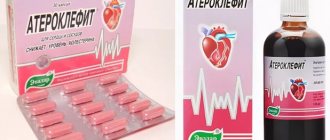Pharmacodynamics and pharmacokinetics
Pharmacodynamics
LP receptors of the liver regulate the content of lipoproteins in the blood. Lipoproteins are removed from the circulating blood by interacting with these receptors and cholesterol . The mechanism of action of Lovastatin is explained by the suppression of 3-hydroxy-3-methylglutaryl-coenzyme A reductase, an enzyme with the participation of which cholesterol synthesis occurs. A decrease in the formation of cholesterol in the liver entails a compensatory increase in the number of lipoprotein receptors on the surface of hepatocytes, as a result of which the removal of low-density lipoproteins from the plasma is accelerated and total cholesterol, intermediate-density lipoprotein cholesterol and very low-density lipoprotein cholesterol .
The drug reduces the content of triglycerides and apolipoprotein B , and slightly increases the level of high-density lipoproteins. The therapeutic effect appears after 14 days, and the maximum effect occurs after 6 weeks from the start of treatment, and persists for 1.5 months after discontinuation of the drug. Efficiency does not decrease with long-term use. Lovaststatin is obtained from biocultures of Monascus ruber and Aspergillus terreus.
Pharmacokinetics
Absorbed into the gastrointestinal tract slowly. Absorption is reduced by taking the drug on an empty stomach. Bioavailability is low - 30% of the dose. After 2-4 hours, the maximum concentration in the blood is reached, which decreases and after 24 hours is 10% of the maximum. 95% binds to blood proteins. Clearance of Lovastatin with a single dose is achieved within 2-3 days. Lovastatin is a prodrug and after the first passage through the liver it acquires the active dosage form. Metabolism occurs with the participation of isoenzymes. The half-life is 3 hours. The active substance and its metabolites are excreted through the intestines and kidneys.
The experience of giving presentations on the use of one of the most widely used classes of drugs today (and the first in terms of sales volumes) - statins, gave the author the opportunity to evaluate the set of questions that are asked in one form or another in a variety of audiences. This work is an attempt to formulate answers to the most common of them.
What class of drugs do statins belong to?
The answer to this question seems obvious. Nine out of ten doctors will immediately answer that statins are cholesterol-lowering drugs. A slightly smaller number, but also a very significant one, will remember that statins inhibit the enzyme HMG-CoA reductase, which converts acetyl-CoA into mevalonic acid, a substance from which cholesterol is formed through a series of transformations. This process occurs inside cells, most actively in hepatocytes. The consequence of inhibition of intracellular cholesterol synthesis is a decrease in its level in the cell. The cell satisfies the need for it by increasing the uptake of cholesterol from the blood, where its concentration, accordingly, decreases. The crux of the matter, however, is not this. There are a significant number of other lipid-lowering drugs, the use of which, however, does not lead to an increase in life expectancy in high-risk patients. Statins differ in that they reduce the risk of adverse outcomes of atherosclerosis. From this point of view, the indication for prescribing a statin is not the level of lipids, but the level of risk.
This key difference between statins and other drugs that correct lipid metabolism sometimes gives reason to consider statins as a separate class of drugs.
However, for convenience, statins are most often called lipid-lowering drugs.
Should statins be prescribed if lipids are normal and to what level should lipids be reduced?
The prescription of statins, according to modern concepts, is indicated for those patients who have an increased risk of developing adverse outcomes of atherosclerosis. Statins reliably and significantly reduce this risk. However, the level of low-density lipoprotein cholesterol (LDL) does not necessarily have to be elevated. Or, in other words, at higher risk, more stringent requirements are placed on LDL levels.
Different countries approach this problem differently. Thus, in the United States today, the prevailing tactic is to more aggressively lower LDL levels. In high-risk groups (risk of death from complications of coronary artery disease > 20% over 10 years), according to American experts, LDL levels should be achieved
The European recommendations of 2003, on the basis of which the domestic ones issued in 2004 are based, use a slightly different approach. The risk is assessed in relation not only to complications of coronary artery disease, but also to other complications of atherosclerosis, primarily cerebrovascular episodes.
These recommendations state that normal values for total cholesterol are 5 mmol/L and LDL cholesterol is 3 mmol/L. If the risk determined from the tables (see figure) or a special calculator is less than 5% over 10 years, the subject is recommended to change his lifestyle. If the risk is higher, a decision is made on drug intervention (first of all, the issue of prescribing statins is considered).
If there are already signs of atherosclerosis or diabetes mellitus, a total cholesterol level below 4.5 mmol/l and an LDL cholesterol level below 2.5 mmol/l are considered normal. To achieve these target levels, statins should be used in these patients.
Before discharge from hospital, patients with myocardial infarction often have normal cholesterol levels. Should statins be prescribed to such patients?
An episode of exacerbation of coronary artery disease is accompanied by fluctuations in cholesterol levels. This is due both to the disease itself and to the use of certain medications (for example, heparin). Today, to determine the “true” lipid level, it is recommended to use data obtained upon admission of the patient to the hospital. For this purpose, determination of blood lipid levels is included in the list of mandatory laboratory parameters that are recorded in the patient during hospitalization. Lipids will return to pre-infarction levels only after three months. In cases where data on lipids on admission are not available, statins should be prescribed based on diagnosis in moderate dosages.
With the statin, blood lipid levels have normalized - how long should the patient continue to take this medicine?
Despite the obviousness of the answer to this question, it arises with enviable frequency.
However, if the answer is precise, then the experience with statins in controlled studies is limited to 3-5 years. Then, after the end of the study, as a rule, patients are recommended to continue taking the drug.
The longest period during which the fate of patients participating in the statin project was tracked was 10 years. These are patients from the 4S trial, the first study to show improved survival in patients treated with simvastatin. The results of this observation suggest that continuing statin therapy for such a long time does not increase the number of side effects.
The differences in the incidence of cardiovascular events that were achieved during the five-year study period, when the effects of the drug were compared with placebo, persisted five years after the end of the study, when the majority of study participants began taking the active drug.
In other words, the answer to this question may sound like this. If indicated, statins should be used long-term, at least until the doctor has something more effective in his hands.
Can statins be prescribed to women before menopause?
Yes, it is possible, however, in the case where the risk of developing adverse outcomes of atherosclerosis makes such a prescription necessary, the woman should be warned about the need for adequate contraception, since the prescription of statins is contraindicated for pregnant women.
Breastfeeding is also a contraindication for the use of statins.
Up to what age should statins be prescribed?
As the results of recent studies conducted with elderly patients show, advanced age is not a reason to deprive such patients of statins. It should be noted, however, that with increasing age, the effectiveness of statins decreases, as other life-limiting conditions of the patient come to the fore. In this case, adding statins to a large list of other medications may not be appropriate. In any case, the decision is always made individually.
Can statins be given to children?
There are a very small number of hereditary conditions for which it is acceptable to prescribe statins to children. However, decisions in this regard should only be made by lipidologists.
How to use the non-lipid effects of statins?
Isolation of the so-called non-lipid (or pleiotropic) action of statins is very fashionable, but rather conditional. Firstly, this is due to the mechanism of action of these drugs. Blockade of mevalonic acid synthesis affects the level of all products formed from this precursor. Therefore, it is very difficult to separate one effect from the other. Secondly, the lipid effect itself can be formed not only by reducing the level of cholesterol synthesis in the liver, but also indirectly, for example, through the influence on special nuclear receptors that regulate the expression of a very large number of genes.
Nevertheless, these effects traditionally include effects on endothelial function, hemostasis factors, and platelets. A fairly powerful anti-inflammatory effect of this class of drugs, etc., has been described.
We are a long way from adding separate indications for statins for these effects, although this additional action may be useful in some patients. This primarily applies to people who, in addition to the risk of dying from cardiovascular disease, have certain diseases, such as rheumatoid arthritis, the course of which statins can improve.
It must be said that many experts believe that the main effect of statins—improving survival in a high-risk group—is rather a consequence of a non-lipid effect. Whether this is true or not will be shown by the results of additional studies currently being conducted.
How to choose a statin?
The group of statins today consists of a number of drugs registered, including in our country. These are lovastatin, simvastatin, pravastatin, atorvastatin, fluvastatin and rosuvastatin. As you can see, there is a choice. However, it is often influenced by only one parameter – the price of treatment. This approach is, of course, wrong. Although the fact that all statins reduce the risk of adverse outcomes of atherosclerosis to one degree or another is beyond doubt, rigorous evidence for this in large multicenter studies was obtained only for lovastatin, simvastatin, pravastatin and atorvastatin. No such studies have been conducted with fluvastatin. Rosuvastatin is a relatively young drug; studies on its use have not yet been completed.
There is reason to believe that the effectiveness of statins on survival correlates to a certain extent with the severity of their lipid-lowering effect. From this point of view, the least effective is fluvastatin, then in order of increasing lipid-lowering effect are pravastatin, lovastatin, simvastatin, atorvastatin and finally rosuvastatin.
The largest number of studies that did not show a significant reduction in adverse outcomes were conducted using pravastatin. The two best studied drugs from this group are simvastatin and atorvastatin. Studies involving the largest number of patients have been conducted using these drugs.
There are few direct comparisons of statins in studies examining the risk of adverse outcomes.
The recently completed IDEAL (Incremental Decrease in Clinical Endpoints Through Aggressive Lipid Lowering) study compared simvastatin and atorvastatin. The study included patients with characteristics very similar to those included in the first successful statin project, the 4S study. A total of 8888 patients who had suffered myocardial infarction and were selected for treatment with statins were divided into two groups: the first received simvastatin (20 mg / day, increasing the dosage to 40 mg if the cholesterol level remained above 190 mg/dl), the second received atorvastatin ( 80 mg/day; when LDL levels dropped below 40 mg/dL, the dose was reduced to 40 mg/day).
After almost a five-year follow-up period, a significant difference in the incidence of the primary end point (coronary death + hospitalization for heart attack + successful resuscitation after cardiac arrest) was not achieved. Myocardial infarction developed not much, but significantly less often in the atorvastatin group. Mortality from coronary artery disease was identical in both groups. Although adverse events that could be a consequence of statin use were reported at similar rates in both groups, drug discontinuation was more common in the atorvastatin group. The incidence of myalgia and cases of elevated liver enzyme levels was also higher when taking atorvastatin.
In other words, using high doses of atorvastatin may have (albeit small) benefits. However, the price for these benefits is more side effects.
For our country, where the difference in the cost of 40 mg of simvastatin and 80 mg of atorvastatin remains significant, the conclusion could be as follows. Simvastatin at a dose of 20–40 mg should be prescribed. If target LDL levels cannot be achieved, a more aggressive statin or combination therapy should be considered.
How to choose a statin dose?
The choice of statin dose is another stumbling block. The tradition of starting treatment with microscopic doses was born in connection with the long-standing belief of conservative doctors that it is better to prescribe at least something than nothing. Today it is already clear: treatment with statins should be carried out using dosages that have been tested in large clinical trials. For the most commonly used statins, these doses are: simvastatin - 20 and 40 mg / day, atorvastatin 10-80 mg / day.
What to do if a statin does not lower lipids sufficiently?
Indeed, not all patients manage to achieve the target LDL level. Moreover, every year, target LDL levels are decreasing more and more, i.e., the number of patients in whom statins were not effective enough is increasing. Several ways out of this situation have been proposed. First, the use of active statins in maximum dosages - atorvastatin at a dose of 80 mg and rosuvastatin at doses of 20 and 40 mg. Unfortunately, there is a kind of “6% rule” for statins. According to him, doubling the dosage of a statin leads to an increase in its effectiveness on LDL levels by only 6%. Moreover, when directly comparing the effects of different statin dosages on specific endpoints, as was done in the TNT (Treating to New Targets study) study, which compared atorvastatin doses of 10 and 80 mg, the differences in the frequency of endpoints, although reaching a significant level , but this difference turned out to be slightly greater than 2% (and this is with an eightfold increase in the dose!).
The second way is a combination with a medicine from another group. Pharmaceutical companies are actively searching in this direction. However, only one drug has reached clinical use (except for combinations with “old” drugs - fibrates, nicotinic acid) - ezetimibe. This medicine, acting on a specific cholesterol transporter in the intestinal wall, reduces its absorption from the lumen of the small intestine and thus lowers its concentration in the blood by blocking the absorption of dietary cholesterol and bile cholesterol. By itself, ezetimibe has a modest effect - it reduces LDL cholesterol by about 20%. At the same time, when added to a statin, it provides a powerful additive effect. Thus, the combination of 10 mg of any of the statins and 10 mg of ezetimibe is equivalent to the administration of 80 mg of statin, if the effect is assessed by the effect on lipids. There are no data yet regarding the effect of this combination on disease outcomes.
About the side effects of statins
The problem of minimizing side effects during treatment with any drug is quite acute. However, for drugs used to reduce the risk of adverse outcomes of a disease in large populations, this problem is especially relevant. In other words, what is the benefit of a medicine for a specific patient is unclear, since the effects appear only when analyzing large groups of patients, but the harm is caused to a specific person.
Statins are one of the most commonly used drugs today. Fortunately, the incidence of adverse reactions due to their use is low.
However, recently the problem of statin safety has become increasingly used as a tool in the competitive struggle of manufacturers. In our country, this approach leads to the opposite effect. Having heard about the side effects of one or another statin, many doctors, without much thought, stopped prescribing statins altogether. Those who, due to conservatism, had not prescribed them before, received in their hands, as it seems to them, a very important weapon against drugs of this group.
The fact that the pathos of the majority of “safety fighters” is not associated with the desire to achieve benefits for patients is clearly illustrated by the fact that in the absence of sponsorship support for this kind of struggle, in our country a drug such as metamizole, better known, which is banned in most countries, is still used. under the name Analgin.
All this, of course, does not exclude the need to remember side effects.
What to do if your liver enzyme levels are elevated?
Elevated liver enzymes are the most common side effect of statins. It is observed in 0.5–2% of cases and depends on the dose of the drug. At the same time, other signs of hepatotoxicity have not been recorded so far against the background of statins.
Although liver diseases are on the list of contraindications to the use of statins, cases of worsening of these diseases due to their use have not yet been described. In patients with hepatitis C and B who have elevated levels of transaminases, the prescription of statins does not lead to a worsening of the disease. Treatment of hyperlipidemia in patients with fatty liver disease may even reduce the level of transaminases in the blood.
However, it is common practice to reduce the dose of the drug when liver enzyme levels increase more than 3 times the normal value. If the initial blood test shows such an increase, you should start with lower doses and monitor enzyme levels more frequently. Sometimes changing the drug leads to normalization of liver enzyme levels.
What is statin myopathy and statin rhabdomyolysis?
One of the most frequently asked questions regarding statins is largely due to some confusion in concepts. First a few definitions:
Myopathy is a general name for any muscle disease. It can be congenital or acquired, observed at birth or manifested throughout life.
Myalgia is pain or muscle weakness that is not accompanied by an increase in creatine phosphokinase (CPK) levels. The syndrome completely resolves within 2–3 weeks after discontinuation of statins.
Myositis is muscle symptoms accompanied by an increase in CPK.
Rhabdomyolysis is muscle symptoms characterized by a significant increase in CPK levels (usually more than 10 times) and an increase in blood creatinine levels. Rhabdomyolysis is usually accompanied by the appearance of brown urine and myoglobinuria. The latter causes acute renal failure and in significant cases leads to the death of the patient. The diagnosis can be confirmed by muscle biopsy.
The whole spectrum of muscle lesions can occur against the background of statins - from myalgia to rhabdomyolysis.
In which patients should side effects be expected?
The myotoxic effect of statins depends on the concentration of the drug in the blood and is associated with conditions that increase it.
These factors are age (especially over 80 years of age, more often in women than men), poor nutrition, comorbidities (for example, renal failure, especially due to diabetes mellitus, or liver failure), polypharmacy, the postoperative period, excessive alcohol consumption and grapefruit juice.
A number of medications significantly increase the risk of complications. These are fibrates (especially gemfibrozil), nicotinic acid, cyclosporine, antifungals (azoles), macrolide antibiotics, verapamil, amiodarone.
Theoretically, certain characteristics of individual statins may also be important. These are lipophilicity, the degree of binding to plasma proteins, and potential interaction with other drugs (especially through the cytochrome P450 CYP3A4 system). In the experiment, lipophilic statins had the greatest myotoxic effect.
Hydrophilic statins practically cannot penetrate into cells due to passive diffusion. At the same time, they are included in hepatocytes due to active transport, for example, with the help of polypeptide C, which transports organic anions. In the experiment, lipophilic statins - atorvastatin, simvastatin and lovastatin, in contrast to hydrophilic pravastatin, damaged muscle cells more and caused a greater increase in CPK levels.
Cerivastatin is the most lipophilic statin, and perhaps this fact was responsible for the large number of cases of rhabdomyolysis with its use, which led to the withdrawal of the drug from the market and the cessation of its production.
Combination of statins with other lipid-lowering drugs
Another possibility for adverse treatment effects to occur is the combined use of statins with other drugs that have lipid-lowering effects. The widespread use (especially in Western countries) of this combination stems from modern ideas about the need for intensive reduction of lipid levels. Today, according to some recommendations, in patients with a high risk of complications of atherosclerosis, LDL should be reduced to a level of less than 1.8 mmol/l. These recommendations explicitly state that combination therapy is often necessary to achieve this level. For combination therapy, a combination with nicotinic acid and an inhibitor of cholesterol adsorption in the intestine, ezetemibe, is used. The combination of statins with nicotinic acid is used quite rarely due to the large number of side effects of the latter. Only isolated cases of rhabdomyolysis have been described when used in combination with lovastatin.
The combination with ezetimibe has not yet resulted in serious side effects.
To further reduce triglyceride levels, especially in patients with diabetes, a combination of statins and fibrates metabolized by cytochrome P450 CYP3A4 is often used.
The riskiest combination is statins and gemfibrozil. It was the combination of cerivastatin with gemfibrozil that caused a large number of myotoxic adverse reactions. Gemfibrozil undergoes extensive glucuronidation by glucuronyl transferase, in particular its isoforms UGT1A1 and UGT1A3, which are also involved in the glucuronidation of statins. Glucuronidation is the main method for eliminating active statin metabolites.
Another fibrate, fenofibrate, interacts with two other isoenzymes, UGT1A9 and UGT2B7, and therefore has a lower potential risk of interaction with statins.
It should be borne in mind that the frequency of complications is still very low, so there is no reason yet to prohibit such combinations. However, one should remember the possibility of the described interaction and monitor such patients more carefully.
What to do if myotoxic effects of statins are detected or suspected?
The necessary actions of a doctor in this situation are summarized in the table.
Naturally, the topic of treating patients with atherosclerosis with statins is so vast that it is impossible to answer all the questions a doctor may have within the framework of such a short article. Moreover, the number of publications relating to this class of drugs is growing exponentially, and some issues are still waiting to be resolved.
Still, we can state with some satisfaction that in our country the number of patients taking statins is growing every year. We hope that this publication will help strengthen this trend.
Side effects
- heartburn , nausea, flatulence , constipation or diarrhea ; very rarely - taste perversion, hepatitis , biliary cholestasis , cholestatic jaundice ;
- headache, dizziness; sleep disorders, insomnia , general weakness, anxiety, paresthesia ;
- myalgia and muscle cramps, myositis ; in patients taking Cyclosporine , Nicotinic acid or Gemfibrozil , there is a risk of developing rhabdomyolysis ;
- hemolytic anemia , thrombocytopenia ;
- optic atrophy , cataracts ;
- increased activity of liver transaminases, creatine phosphokinase activity; very rarely alkaline phosphatase and bilirubin.
- rash, itching, angioedema , urticaria , arthralgia ;
- very rarely, decreased potency and alopecia .
Lovastatin, instructions for use (Method and dosage)
Tablets are taken orally 1 time per day during dinner. For hyperlipidemia - from 10 to 80 mg once, depending on the severity of hyperlipidemia. Treatment begins with a small dose, then gradually increases it. The maximum daily dose of 80 mg can be taken in one or two doses (morning and evening). Dose selection is carried out at intervals of 4 weeks.
For coronary atherosclerosis, the dose is 20–40 mg. If ineffective, increase to 60–80 mg. When taking fibrates or nicotinic acid , the dose of Lovastatin should not exceed 20 mg per day.
Overdose
If the recommended doses of the drug are exceeded, an overdose cannot be ruled out. Treatment is symptomatic, aimed at alleviating the current condition. Absorbents, enterosorbents, and diuretics may be prescribed. The patient should drink plenty of fluids.
If the recommended dosage is exceeded and side symptoms develop, drugs from the group of enterosorbents are prescribed
Important! The hemodialysis procedure is effective only in severe cases of poisoning.
Interaction
Taking with Nicotinic acid , Erythromycin , Clarithromycin , Cyclosporine , antifungal drugs ( Ketoconazole , Itraconazole ), Ritonavir , Nefazodone leads to an increase in the concentration of the drug, the risk of developing myopathy and destruction of muscle tissue.
Simultaneous intake of large amounts of grapefruit juice, Gemfibrozil , Fenofibrate also carries a risk of developing myopathies.
Co-administration of Warfarin increases the risk of bleeding.
Cholestyramine reduces the bioavailability of the drug, so the time between taking these drugs should be 2-4 hours.
Lovastatin analogues
Level 4 ATX code matches:
Akorta
Atomax
Lipitor
Pravastatin
Simvastol
Owencore
Simgal
Tulip
Liptonorm
Rozulip
Zokor
Rosart
Tevastor
Atorvastatin
Liprimar
Simvastatin
Atoris
Basilip
Rosecard
Roxera
Apexstatin , Cardiostatin , Vero-Lovastatin , Choletar , Mevacor , Lovacor , Lovasterol , Mevinacor , Pravastatin , Iinvastin , Fluvastatin .
Reviews of Lovastatin
Lipid-lowering drugs are used in complex treatment and for the prevention of atherosclerosis and its complications. Their main effect is to reduce the content of atherogenic lipoproteins in the blood. Representatives of the statin group (in order of increasing effect) are: Lovastatin , Simvastatin , Fluvastatin , Pravastatin , Atorvastatin and Rosuvastatin . Often, as the main effect increases, the risk of side effects also increases.
Extensive experience has been accumulated in the clinical use of Lovastatin, which is the safest drug and is well tolerated during long-term treatment. According to patient reviews, side effects appeared quite rarely: flatulence , diarrhea or constipation , abdominal pain, insomnia, muscle pain. As a rule, these reactions disappeared after 2 weeks of taking the drug or after reducing the dose. If the levels of AST and ALT increased after a month, the tests were monitored and the dose of the drug was reduced. After 1.5-2 months from the start of treatment, a control determination of lipid levels was carried out and positive dynamics were noted in the tests.
Indications for use
Lovastatin is used to diagnose the following conditions:
- hypercholesterolemia (primary type IIa/IIb, combined)
- hypertriglyceridemia;
- hyperlipoproteinemia;
- atherosclerosis.
Cholesterol synthesis and the effect of statins on the level of the substance in the body
The medication is used in patients with diabetes to prevent the development of serious complications. Treatment with Lovestatin can be combined with antihyperglycemic drugs. Taking a lipid-lowering drug is possible to prevent the development of pathologies of the heart and blood vessels. This is especially true for possible relapses of heart attack, stroke and others. In this case, it is prescribed in combination with cardiac medications.
No ads 1






